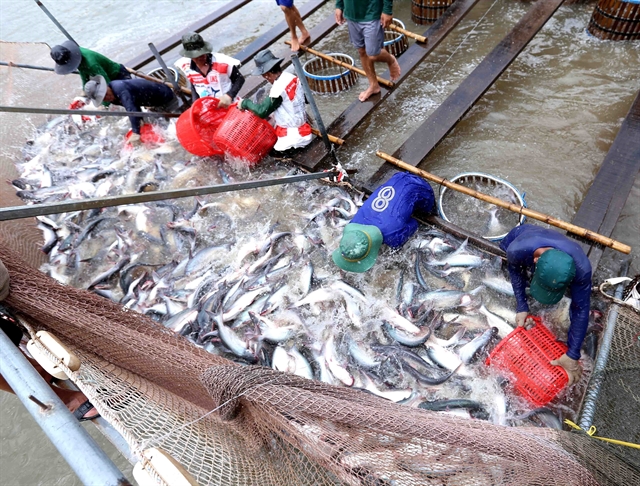 Economy
Economy

Việt Nam’s tra fish (pangasius) industry has been urged to strongly improve its quality so as to compete with not only traditional rivals, but also its biggest tra fish importer – China.

|
| Tra fish products will face competitiveness from China's products. — Photo kinhtenongthon.vn |
HCM CITY — Việt Nam’s tra fish (pangasius) industry has been urged to strongly improve its quality so as to compete with not only traditional rivals, but also its biggest tra fish importer – China.
According to the Việt Nam Association of Seafood Exporters and Producers (VASEP), the domestic tra fish sector faces many rivals, including China, India, Indonesia, and Bangladesh – who each represent around 15-20 per cent of global production.
Experts said the competitiveness of Vietnamese tra fish should not be assessed through only quantity, but the quality of material and products is the key.
To deal with this issue, a high-tech tra fish farm covering 600 ha will be developed in the Mekong Delta province of An Giang in the fourth quarter of this year. When operational, it is expected to supply around 200,000 tonnes of high-quality raw materials each year for processing and subsequent export.
VASEP Secretary General Trương Đình Hòe said once the quality of Vietnamese tra fish is improved and wins the trust of consumers in demanding markets, it will also have more opportunities to be sold well on the e-commerce platform of Alibaba of China as well as on Amazon of the US.
“Through the e-commerce website (Alibaba), Việt Nam’s tra fish products will have greater chances to enter this giant market,” he added.
The global production of farmed tra fish was estimated at 2.8 million tonnes in 2018, up 6 per cent from the previous year, and about 45 per cent of this total was sourced from Việt Nam, mostly in the Mekong Delta, according to the association.
As of March 2019, there were 20 tra fish processing factories in China whose production capacity had reached some 30,000 tonnes per year. This fact indicates that China is likely to become a big rival to Việt Nam’s tra fish industry in the near future, VASEP said.
Meanwhile, the Ministry of Agriculture and Rural Development has also warned that Việt Nam would have to face more competition from India when this nation has exported seafood products, especially black tiger shrimp, to Japan, one of the traditional export markets of Vietnamese seafood.
India has targeted to triple the domestic seafood output with support from the Government by promoting development of projects relating to the production of shrimp varieties.
Besides that, India will focus on promoting tiger shrimp farming in West Bengal, Kerala and Karnataka to boost exports of commercial shrimp products to the Japanese market, especially in the 2020 Tokyo Olympics, an event that is expected to boost seafood consumption in Japan.
According to the ministry, Việt Nam’s seafood export value in the first three months of this year reached US$1.8 billion, a year-on-year increase of 0.5 per cent, including $645 million in March.
Japan, the US, China and South Korea are the top four export markets of Vietnamese seafood in the first two months of 2019, accounting for 52.8 per cent of the total seafood export value, the ministry said.
The markets with strong growth in seafood export value included Mexico (up 35.6 per cent), the Philippines (25 per cent), Malaysia (21.6 per cent, the UK (16.6 per cent) and Canada (13.7 per cent).
The ministry said prices of tra fish and shrimp reduced in March due to a drop in export orders of those seafood products.
The purchasing price fell by VNĐ3,000 per kilo month on month for tra fish to VNĐ24,000-25,000 and by VNĐ40,000-70,000 per kilo for black tiger shrimp VNĐ190,000-300,000. — VNS




